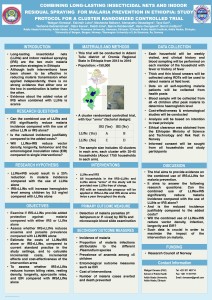Entomological collections in areas targeted for a cluster randomized controlled trial to prevent malaria in Ethiopia: Results from a pilot study
Oljira Kenea1, Meshesha Balkew1, Teshome Gebre-Micheal1, Taye Gari2, Eskindir Loha2, Wakgari Deressa1,Alemayehu Dessalegn1, Bjarne Robberstad3, Hans J Overgaard4, Bernt Lindtjørn3
1 Addis Ababa University, Addis Ababa, Ethiopia.2HawassaUniversity, Hawassa, Ethiopia. 3University of Bergen, Bergen, Norway.4Norwegian University of Life Sciences, Ås, Norway.
Objective Indoor residual spraying (IRS) and long-lasting insecticidal nets (LLINs) are the core malaria vector control tools in Ethiopia. Combining both in the same household as a vector control strategy is widespread but entomological outcomes of such interventions are little known. This pilot study was carried out to provide basic information about local malaria vector population for effective planning and implementation of IRS and LLINs cluster randomized trial.
Methodology The study was conducted from June to October 2013 in Adami Tulu district, central Ethiopia. Indoor mosquito collections were done using CDC light traps and pyrethrum spray sheet catches. Outdoor collections were done from artificial pit shelters. Mosquitoes were identified to species by morphological characteristics and polymerase chain reaction (PCR). Enzyme-linked immunosorbent assays (ELISA) were carried out to detect the sources of host blood meals and circum-sporozoite proteins. Mosquito longevity was estimated using parity based on dilatation of ovarian tracheoles following dissection. Data were managed and analyzed using SPSS version 20.0 and a p value< 0.05 was considered to be statistically significant.
Results All Anopheles gambiae mosquitoes were confirmed to be An. arabiensis by PCR. Of 232 adult Anopheles mosquitoes collected, An. arabiensis (71.1%) was the predominant species followed by An. pharoensis (21.1%). The overall average Anopheles density varied within and among the villages over the study months. All of the mosquitoes (n = 232) that were analyzed by ELISA were negative for Plasmodium falciparum and P. vivax circum-sporozoite proteins. The overall Human Blood Index (69.2%) for An. arabiensis was higher than Bovine Blood Index (38.4%) and it was higher for populations collected indoors (73%) than those collected outdoors (21%). Average longevity of An. arabiensis and An. pharoensis ranged from 7 to 25 and 1.6 to 6.3 days, respectively.
Conclusion The density of An. arabiensis, the main malaria vector in Ethiopia, varied within and among the villages over the study months. This study provided preliminary information needed for effective planning and implementation of LLINs and IRS combined intervention trial against malaria in Adami Tulu district, central Ethiopia.

